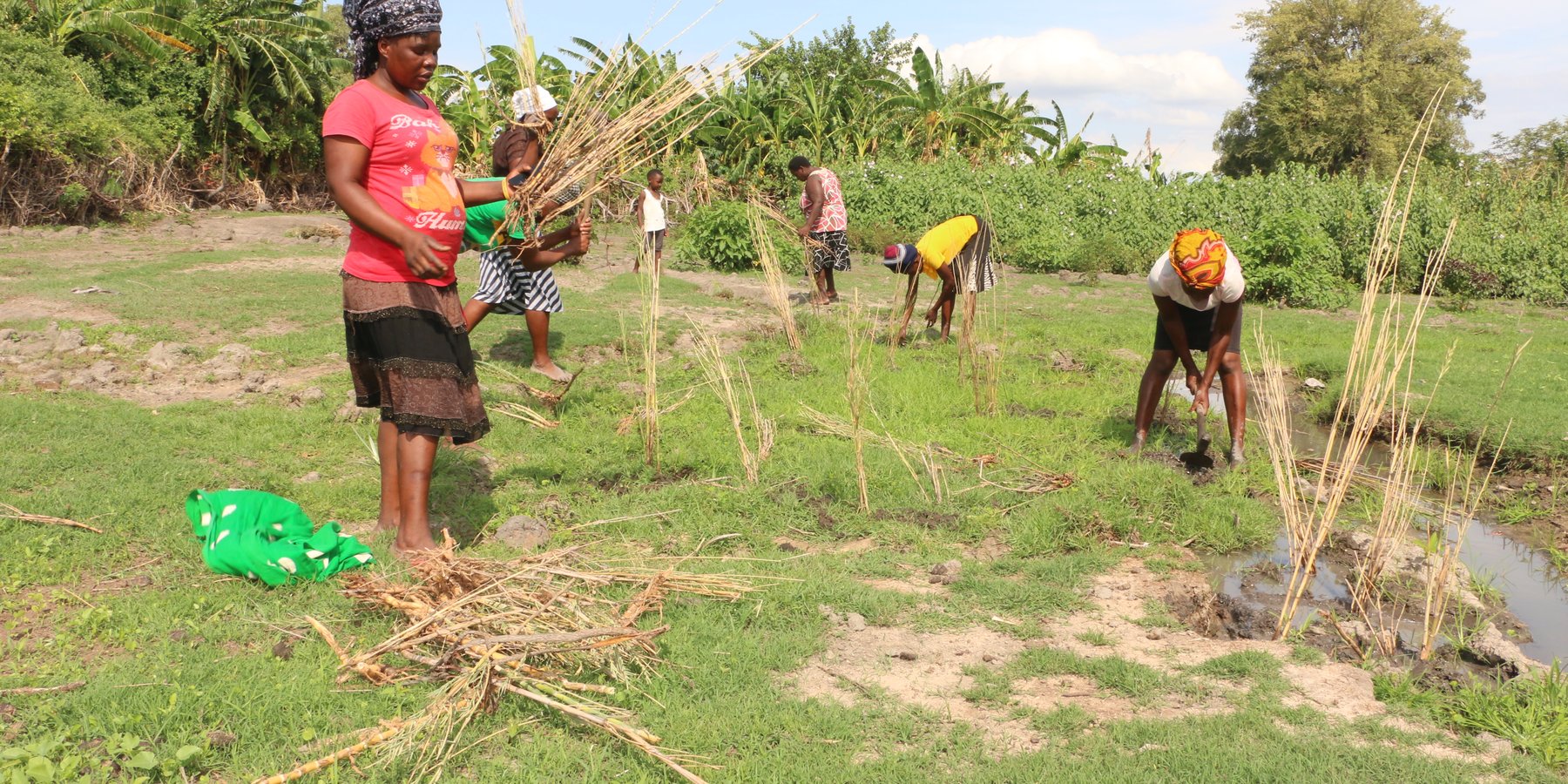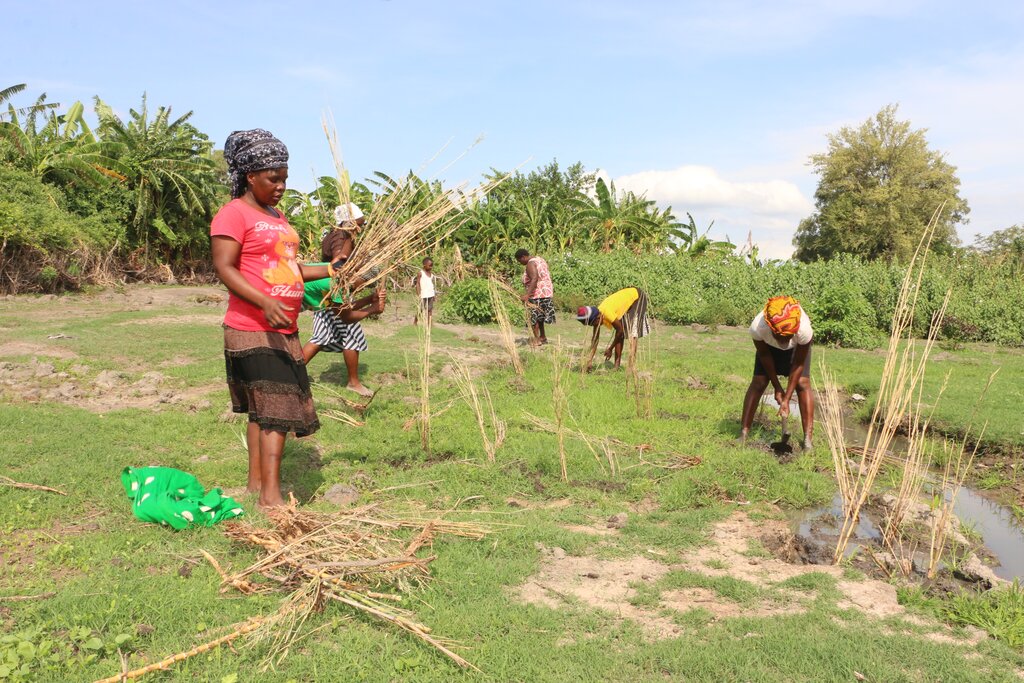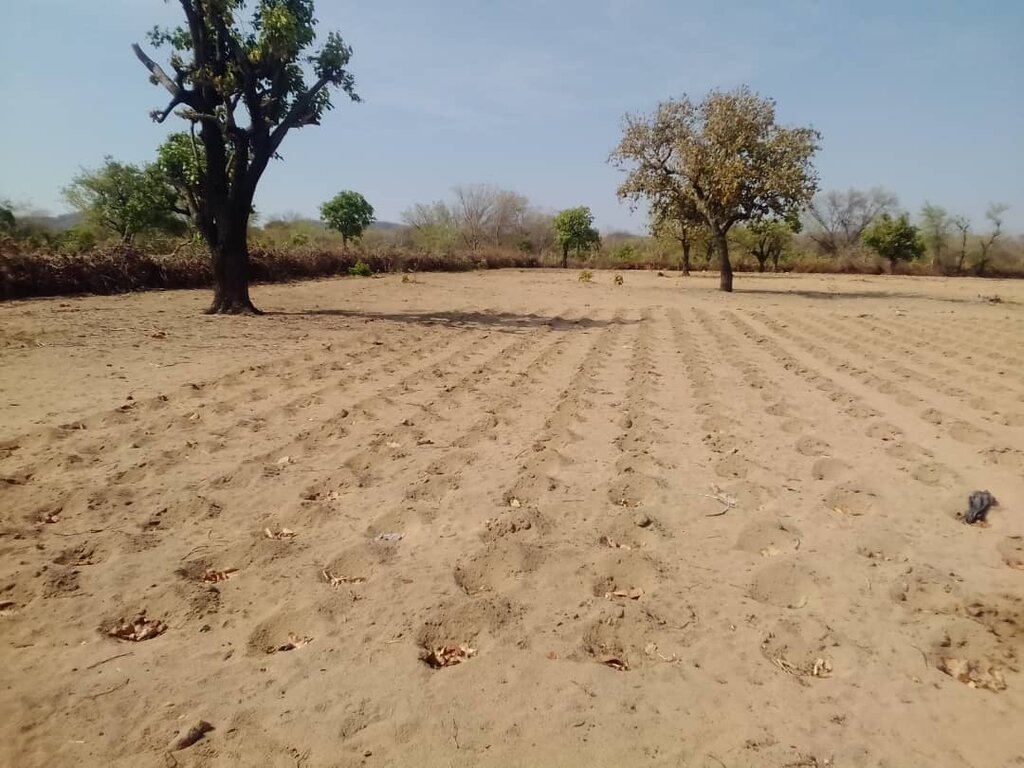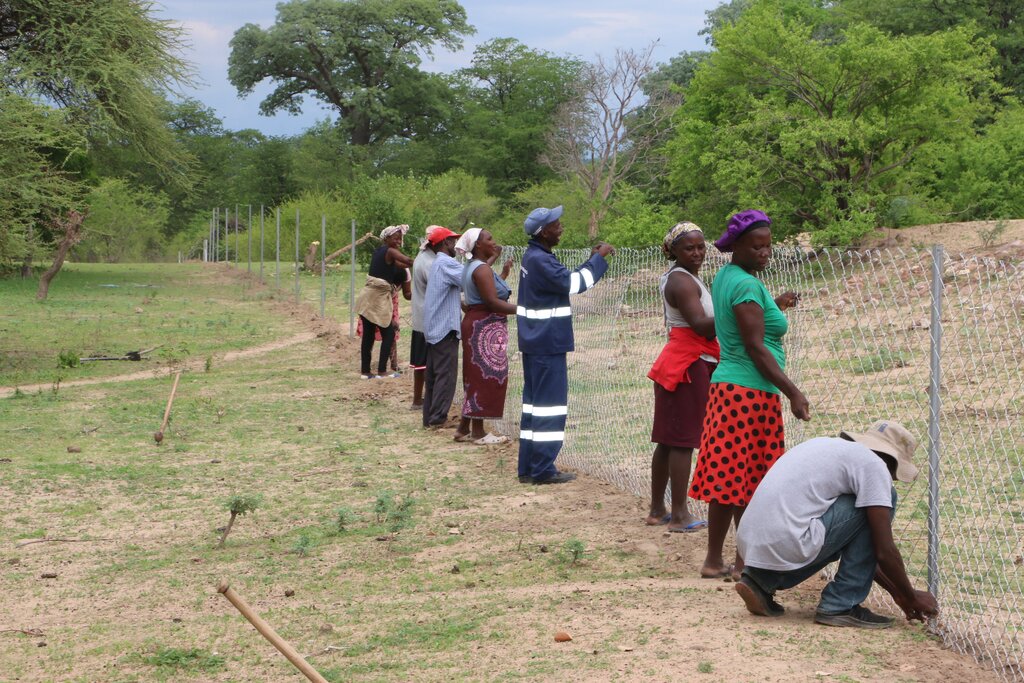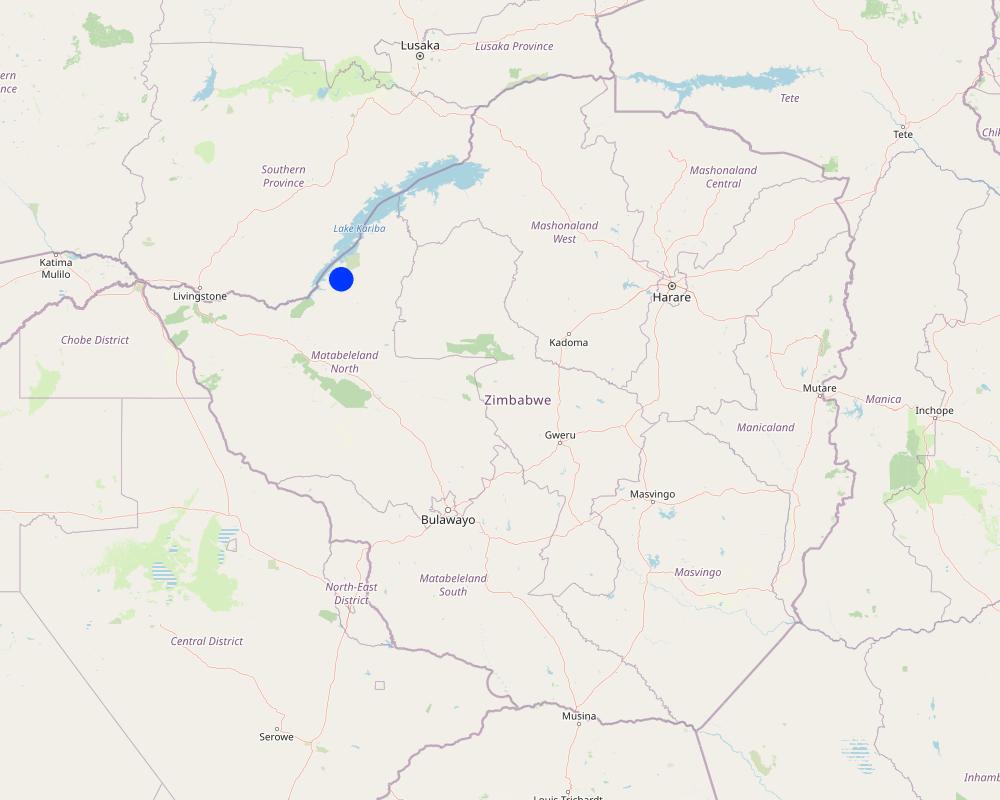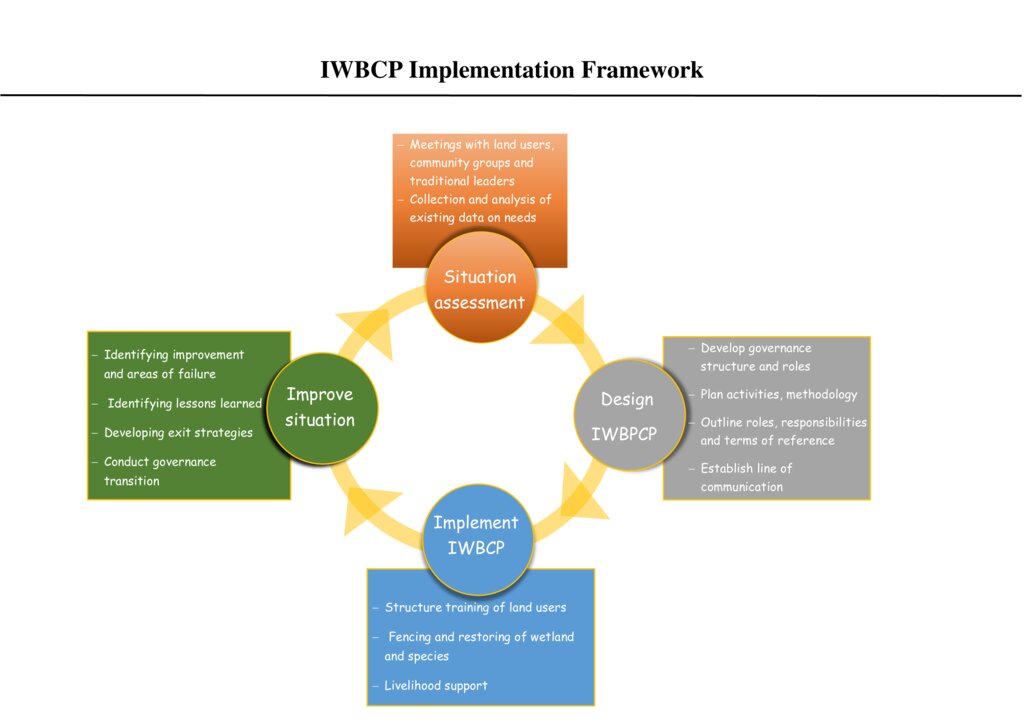Integrated Wetlands Biodiversity Conservation Project [ซิมบับเว]
- ผู้สร้างสรรค์:
- การอัพเดท:
- ผู้รวบรวม: Kalulu Mumpande
- ผู้เรียบเรียง: –
- ผู้ตรวจสอบ: William Critchley, Joana Eichenberger
IWBCP
approaches_7367 - ซิมบับเว
ดูส่วนย่อย
ขยายทั้งหมด ย่อทั้งหมด1. ข้อมูลทั่วไป
1.2 รายละเอียดที่ติดต่อได้ของผู้รวบรวมและองค์กรที่เกี่ยวข้องในการประเมินและการจัดเตรียมทำเอกสารของแนวทาง
วิทยากรหลัก
co-compiler:
Mumpande Kalulu
+263773667529 / +263773667529
mumpandekalulu@yahoo.com / safesewa@gmail.com
Safe Environment & Wildlife Africa
Stand No. 1659 Medium Density Binga
ซิมบับเว
ผู้เชี่ยวชาญ SLM:
Mumkombwe Jane
+263 773666246 / +263 773666246
katemunkombwe46@gmail.com / katemunkombwe46@gmail.com
Agriculture & Rural Development Advisory Services (ARDAS)
Binga medium Density Stand no// 872 Binga
ซิมบับเว
ผู้ใช้ที่ดิน:
Susan Mwembe
+263782644815 / +263782644815
Nil / Nil
Smallholder Farmer
Manjolo Primary School P.O Box 10 Binga
ซิมบับเว
ผู้ใช้ที่ดิน:
Mudenda Naison
+263771152184 / +263771152184
Nil / Nil
Smallholder Farmer
Manjolo Primary School P.O Box 10 Binga
ซิมบับเว
Indigenous Knowledge Guardian:
Mwembe Nomai
+263775256810 (Daughter) / +263775256810 (Daughter)
Nil / Nil
Community Elderly
Manjolo Primary School P.O Box 10 Binga
ซิมบับเว
ชื่อของโครงการซึ่งอำนวยความสะดวกในการทำเอกสารหรือการประเมินแนวทาง (ถ้าเกี่ยวข้อง)
Safe Environment & Wildlife Africa (SEWA)1.3 เงื่อนไขที่เกี่ยวข้องกับการใช้ข้อมูลที่ได้บันทึกไว้ผ่านทาง WOCAT
วันที่เก็บรวบรวมข้อมูล (ภาคสนาม):
21/10/2024
ผู้รวบรวมและวิทยากรหลักยอมรับเงื่อนไขเกี่ยวกับการใช้ข้อมูลที่ถูกบันทึกผ่านทาง WOCAT:
ใช่
2. คำอธิบายของแนวทาง SLM
2.1 การอธิบายแบบสั้น ๆ ของแนวทาง
The integrated wetlands biodiversity conservation project aims to restore wetlands and associated biodiversity. The approach strengthens the resilience of neighbouring marginalized groups to climate change through developing lifelong skills and providing livelihoods support.
2.2 การอธิบายอย่างละเอียดของแนวทาง
การอธิบายอย่างละเอียดของแนวทาง:
The Integrated Wetlands Biodiversity Conservation Project aims to restore wetlands and associated biodiversity. It is a 2-year project which started in June 2023 with the support of a USD 50,000.00 grant from the Global Environment Facility Small Grants Programme, implemented by the United Nations Development Programme (UNDP-GEFSGP). The approach strengthens the resilience of neighbouring community to climate change through developing lifelong skills and providing livelihood support. It targets those marginalized groups surrounding protected areas, who experience severe droughts due to high cases of human-wildlife conflicts, making them highly food insecure. The approach is simultaneously improving sustainable management and utilization of the Masibinta wetland and its catchment.
Technical activities are targeted at restoring Masibinta wetland’s ecological integrity by protecting the wetland, implementing conservation agriculture in its catchment, reforesting bare land, controlling and reshaping gullies to create small ponds, and removing a bushy invasive species (Ipomoea carnea) while making compost from its leaves and branches. The ponds increase the recharge of the wetland. This helps provide water to the community and at the same time acts as a barrier to soil erosion and epicenters for natural vegetative cover regeneration and biodiversity restoration. Land degradation neutrality is an overall goal.
Specific targets include:
(a) Protection, rehabilitation and conservation of 13 hectares of Masibinta wetlands, as well as reclamation of degraded land in and around the wetland, while increasing the capacity of the community members to conserve biodiversity.
(b) Increasing access of 387 households to adequate and clean water.
(c) Reduction of invasive species in the wetlands by 80%, and reclamation of 1000 m of gullies.
(d) Promotion of sustainable use and management of Masibinta wetland through regenerative agriculture, livelihood support and imparting lifelong skills to 50 youths (30 females and 20 males).
A variety of technical and social methods are employed:
(a) Grey and Green Infrastructure (GGI): hybrid restoration techniques that involve the combination of engineered structures and Nature-based Solutions (NbS).
(b) Regenerative agriculture: including mulching, mixed cultivation, crop rotation, agroforestry, use of organic manure in nutrition gardens, and zero tillage (“Maganko”).
(c) Incentives: monetary incentives to the community members who offer their labour.
(d) Self-mobilization.
(e) Peer-to-peer learning.
(f) Problem-solving.
The stages of implementation involved are:
(a) Baseline survey,
(b) Education and training of project support staff, stakeholders,
(c) Monitoring, Evaluation and Learning (MEL),
(d) Livelihood support,
(e) Protection of the wetland, then MEL,
(f) Borehole Drilling,
(g) Invasive species management, then MEL,
(h) Gully modification, and
(i) Evaluation and Learning.
The stakeholders involved and their roles are:
(a) Environmental Management Agency (EMA): Implement and monitor restoration activities in the wetland and assess the impact of barricading the gully on the environment.
(b) Forestry Commission (FC): Nursery establishment, management and tree planting.
(c) Agriculture and Rural Advisory Services (ARDAS): Train farmers on agroforestry, goat rearing, climate-smart agriculture, gully reclamation, and polyculture.
(d) Rural and Infrastructure Development Agency (RIDA): oversees all engineering work.
(e) Ministry of Youth Empowerment Development and Vocational Training (MYEDVT): Monitoring youth engagement and benefits.
(f) Ministry of Women Affairs Community Small and Medium Enterprises Development (MWACSMED): Tracked and monitored inclusion and entrepreneurship.
(h) United Nations Development Programme – Grant disbursement, monitoring and evaluating the implementation and sustainability of IWBCP at the national level in line with the GEFSGP expectations.
2.3 รูปภาพของแนวทาง
2.4 วีดีโอของแนวทาง
วันที่:
02/02/2024
สถานที่:
Manjolo
ชื่อของผู้ถ่ายวีดีโอ:
Kalulu Mumpande
2.5 ประเทศ ภูมิภาค หรือสถานที่ตั้งที่ได้นำแนวทางไปใช้
ประเทศ:
ซิมบับเว
ภูมิภาค/รัฐ/จังหวัด: :
Matebeleland North
ข้อมูลเฉพาะเพิ่มเติมของสถานที่ตั้ง:
Binga
ความคิดเห็น:
Masibinta wetland, surrounded by bare catchment areas
Map
×2.6 วันที่เริ่มต้นและสิ้นสุดของแนวทาง
ระบุปีที่เริ่ม:
2023
ถ้าไม่รู้ปีที่แน่นอนให้ประมาณวันที่ที่ริเริ่มใช้แนวทางนี้ :
น้อยกว่า 10 ปี (เร็วๆนี้)
การสิ้นสุดลง (ถ้าแนวทางไม่ได้ใช้อีกต่อไป):
2025
2.7 ประเภทของแนวทาง
- ใช้โครงงานหรือแผนงานเป็นฐาน
2.8 เป้าหมายหรือวัตถุประสงค์หลักของแนวทาง
The Approach aimed at developing an environmentally responsive community, capable of managing and utilizing Masibinta Wetland most sustainably through:
(a)Increasing knowledge and skills in restoring degraded and conserving the restored land
(b)Improving perceptions on biodiversity and building best practices which promote sustainability of the natural resources capital
(c)Increasing conservation benefit sharing and improving governance of the natural resources
2.9 เงื่อนไขที่เอื้ออำนวยหรือเป็นอุปสรรคต่อการนำเทคโนโลยีภายใต้แนวทางนี้ไปปฏิบัติใช้
การร่วมมือหรือการทำงานประสานกันของผู้ลงมือปฏิบัติ
- เอื้ออำนวย
Collaboration between the stakeholder and the community enabled the Approach to win a Provincial Award: Excellence in Biodiversity Restoration and Social Impact.
กรอบแนวทางในการดำเนินการด้านกฎหมาย (การถือครองที่ดิน สิทธิในการใช้ที่ดินและน้ำ)
- เป็นอุปสรรค
Land is owned along family lines which make it difficult to restore. For example a 100-meters portion of a gully which was reclaimed was later cleared to paved a way for a garden by the family member.
นโยบาย
- เป็นอุปสรรค
Lack of policy on conservation cultivation
ความรู้เกี่ยวกับ SLM การเข้าถึงการสนับสนุนด้านเทคนิค
- เป็นอุปสรรค
The stakeholders have limited knowledge on disaster risk reduction and regenerative farming
ตลาด (จัดซื้อปัจจัยนำเข้า ขายผลิตภัณฑ์) และราคา
- เป็นอุปสรรค
Limited access to markets which offers competitive prices for the landers as producers.
ปริมาณงานที่ทำได้ กำลังคนที่มีให้
- เป็นอุปสรรค
The work load is huge and the manpower is limited. The support staff were on a voluntary contract.
3. การมีส่วนร่วมและบทบาทของผู้มีส่วนได้ส่วนเสียที่เกี่ยวข้อง
3.1 ผู้มีส่วนได้ส่วนเสียที่เกี่ยวข้องในแนวทางนี้และบทบาท
- ผู้ใช้ที่ดินระดับท้องถิ่นหรือชุมชนระดับท้องถิ่น
Traditional leaders and community members
Community members provided labour and security of materials and food during the Approach's activities. They also monitored and evaluated the Approach and provided valuable lessons. Traditional leadership provided the approach's local oversight role, whipped members into line, provided Indigenous knowledge, and guided the implementation process in accordance with the values and beliefs of the Manjolo community. Traditional leadership was key in information dissemination and resolution of issues which would otherwise affect the success of the Approach
- ผู้เชี่ยวชาญ SLM หรือที่ปรึกษาการเกษตร
Agriculture & Rural Development Advisory Services (ARDAS), ZimParks, Forest Commission, Environmental Management Agency (EMA), Small to Medium Enterprises, Ministry of Youth, Social Development, Ministry of Information, Ministry of Health and Child Welfare
Provided technical support, training community members, and local management committees. Supervising activities and evaluating the Approach
- รัฐบาลระดับท้องถิ่น
Binga District Development Committee
Monitoring and Evaluation of the Approach
Providing supportive framework and ensuring that the Approach keep in line with the district's development agenda
ถ้ามีผู้มีส่วนได้ส่วนเสียหลายคนที่เกี่ยวข้องให้ระบุหน่วยงานตัวแทน:
Environment Management Agency (EMA) and Agriculture & Rural Development Advisory Services (ARDAS)
3.2 การเกี่ยวข้องของผู้ใช้ที่ดินระดับท้องถิ่นหรือชุมชนระดับท้องถิ่นในช่วงต่างๆของแนวทาง
| ความเกี่ยวข้องของผู้ใช้ที่ดินระดับท้องถิ่นหรือชุมชนระดับท้องถิ่น | ระบุผู้ที่มีส่วนเกี่ยวข้องและอธิบายกิจกรรม | |
|---|---|---|
| การริเริ่มหรือการจูงใจ | ระดมกำลังด้วยตนเอง | Smallholder farmers The initiation began in October 2022 where the organized a meeting and invited SEWA. At this meeting the farmer highlighted the degradation of Masibinta wetland and how the degradation was negatively affecting their lives. The farmers gave suggestion on possible solutions to the challenges faced. |
| การวางแผน | ปฏิสัมพันธ์ | Smallholder farmers, youth, traditional leaders, local business community, church leaders, teachers, Rural Care Givers, Health Workers, Resources Monitors, Counsellors, People with Disability In December 2022, the farmers who initiated the Approach mobilized community members to a planning meetings, developed activities, pledged own contribution to the Approach, outlined roles of each social group in the Approach, developed ways of mobilizing locally available materials and selected management committees and local lines of communication. They also identified potential challenges and suggested ways of dealing with the challenges that could otherwise arise from the Approach |
| การดำเนินการ | ปฏิสัมพันธ์ | The smallholder farmers, traditional leaders, local business community, youth, church leaders, teachers, Rural Care Givers, Health Workers, Resources Monitors, Counsellors, People with Disability The implementation started in July 2023 after GEFSGP had supported the Approach with a grant of $50,000.00 through the UNDP. The community members worked together and provided labour and security of materials and food during the Approach's activities. They also monitored and evaluated the Approach and provided valuable lessons. Traditional leadership provided the approach's local oversight role, whipped members into line, provided Indigenous knowledge, and guided the implementation process in accordance with the values and beliefs of the Manjolo community. Traditional leadership was key in information dissemination and resolution of issues which would otherwise affect the success of the Approach |
| การติดตามตรวจสอบหรือการประเมินผล | ปฏิสัมพันธ์ | Small holder farmers, youth, traditional leaders, local business community, church leaders, teachers, Rural Care Givers, Health Workers, Resources Monitors, Counsellors, and People with Disability, These provided the views on how the Approach impacted their lives and also on what needed to be changed. |
3.3 แผนผังแสดงขั้นตอนการทำงาน (ถ้ามี)
คำอธิบาย:
Integrated Wetland Biodiversity Conservation Project (IWBCP) Implementation framework
ผู้เขียน:
Mumpande Kalulu
3.4 การตัดสินใจเลือกใช้เทคโนโลยี SLM
ระบุผู้ที่ทำการตัดสินใจเลือกเทคโนโลยีมากกว่าหนึ่งวิธีไปปฏิบัติใช้:
- ผู้ลงมือปฏิบัติที่เกี่ยวข้องทั้งหมดในฐานะที่เป็นส่วนรวมของแนวทาง
ระบุว่าการตัดสินใจตั้งอยู่บนพื้นฐานของ:
- ประสบการณ์และความคิดเห็นส่วนตัว (ไม่ได้ลงบันทึกไว้)
4. การสนับสนุนด้านเทคนิค การสร้างขีดความสามารถ และการจัดการด้านความรู้
4.1 การสร้างขีดความสามารถ / การอบรม
ได้มีการจัดอบรมให้แก่ผู้ใช้ที่ดินหรือผู้มีส่วนได้ส่วนเสียคนอื่น ๆ หรือไม่:
ใช่
ถ้าเกี่ยวข้อง ให้ระบุ เพศ อายุ สถานภาพ ชาติพันธุ์ เป็นต้น:
124 smallholder farmers (69 females, 55 males), 10 Village Heads (2 females, 11males), and 2 Ward-based Environment Monitors (all males) were capacity developed from the 32 hours structured training on land and biodiversity restoration and conservation. During the training the participants were engaged through presentations, drama, role plays, scenarios, problem-solving and field trips. The key stakeholders drawn from government line ministries, and Binga Rural District Council trained the the beneficiaries.
รูปแบบการอบรม:
- กำลังดำเนินการ
- เกษตรกรกับเกษตรกร
- จัดการประชุมสู่สาธารณชน
หัวข้อที่พูด:
Biodiversity conservation, project infrastructure management, sustainable land management, agroforestry, gully reclamation, conservation farming, climate change, and environmental policies
ความคิดเห็น:
The training sessions were not enough due to limited budget. Each training was conducted conducted over for 8hrs and the participants had little time for hands-on participation.
4.2 การบริการให้คำแนะนำ
ผู้ใช้ที่ดินมีการเข้าถึงการรับบริการให้คำปรึกษาหรือไม่:
ใช่
ระบุว่ามีบริการให้คำปรึกษาหรือไม่:
- ไปเยี่ยมชมสถานที่
- ที่ศูนย์ถาวร
การอธิบาย/แสดงความคิดเห็น:
The Rural & Infrastrure Development Agency , Forest Commission and Agriculture & Rural Development Advisory Services provided advisory services to land users crop fields preparation, gully reclamation, tree planting, and wetland management
4.3 การเสริมความแข็งแกร่งให้กับสถาบัน (การพัฒนาองค์กร)
สถาบันได้รับการจัดตั้งขึ้นมาหรือเสริมความแข็งแกร่งโดยแนวทางนี้หรือไม่:
- ใช่ ปานกลาง
ระบุระดับของสถาบันที่ได้รับการเสริมความแข็งแกร่งหรือจัดตั้งขึ้นมา:
- ท้องถิ่น
อธิบายถึงสถาบัน บทบาทและความรับผิดชอบ สมาชิก เป็นต้น:
Community Management Committee and local constitution
Supervision of the land users and enforcing constitution
ระบุประเภทของการให้ความช่วยเหลือสนับสนุน:
- การสร้างขีดความสามารถ / การอบรม
ให้รายละเอียดเพิ่มเติม :
The management committee was trained once on their roles. However, more structured training would enhance their discharge of duties
4.4 การติดตามตรวจสอบและประเมินผล
การติดตามตรวจสอบและประเมินผลเป็นส่วนหนึ่งของแนวทางหรือไม่:
ใช่
ความคิดเห็น:
Continuous monitoring was carried out by the Approach support staff. Monitoring and Evaluation was done quarterly, involving all key stakeholders
ถ้าตอบว่าใช่ แสดงว่าการจัดเตรียมเอกสารนี้มุ่งหวังที่จะเอาไปใช้สำหรับการติดตามตรวจสอบและประเมินผลใช่หรือไม่:
ไม่ใช่
4.5 การวิจัย
การวิจัยเป็นส่วนหนึ่งของแนวทางหรือไม่:
ไม่ใช่
5. การสนับสนุนด้านการเงินและวัสดุอุปกรณ์
5.1 ระบุงบประมาณประจำปีสำหรับแนวทาง SLM นี้
ระบุงบประมาณประจำปีสำหรับแนวทาง SLM นี้ เป็นหน่วยดอลลาร์สหรัฐ:
25000.00
แสดงความคิดเห็น (แหล่งของการระดมทุน ผู้บริจาคคนสำคัญ):
-Co-funding
-Global Environment Facility Small Grants Programme, implemented by the United Nations Development Programme (UNDP_GEFSGP)
5.2 การสนับสนุนด้านการเงิน / วัสดุอุปกรณ์ให้แก่ผู้ใช้ที่ดิน
ผู้ใช้ที่ดินได้รับการสนับสนุนด้านการเงิน / วัสดุอุปกรณ์ไปปฏิบัติใช้เทคโนโลยีหรือไม่:
ใช่
ถ้าใช่ ให้ระบุประเภทของการสนับสนุน เงื่อนไขและผู้จัดหามาให้:
Fencing materials, stationary, cement, goats, seed inputs
Provider: UNDP_GEFSGP
5.3 เงินสนับสนุนสำหรับปัจจัยนำเข้า (รวมถึงแรงงาน)
- อุปกรณ์
| ระบุปัจจัยนำเข้าที่ได้รับการสนับสนุน | เห็นด้วยระดับไหน | ระบุเงินสนับสนุน |
|---|---|---|
| เครื่องมือ | ได้รับการช่วยเหลือทางการเงินบางส่วน | |
| Fencing material | ได้รับการช่วยเหลือทางการเงินแบบเต็ม | |
- การเกษตร
| ระบุปัจจัยนำเข้าที่ได้รับการสนับสนุน | เห็นด้วยระดับไหน | ระบุเงินสนับสนุน |
|---|---|---|
| เมล็ด | ได้รับการช่วยเหลือทางการเงินบางส่วน | |
- โครงสร้างพื้นฐาน
| ระบุปัจจัยนำเข้าที่ได้รับการสนับสนุน | เห็นด้วยระดับไหน | ระบุเงินสนับสนุน |
|---|---|---|
| Fence | ได้รับการช่วยเหลือทางการเงินแบบเต็ม | |
ถ้าแรงงานโดยผู้ใช้ที่ดินเป็นปัจจัยนำเข้าที่มีอยู่มากมาย ระบุด้วยว่าเนื่องจาก:
- สมัครใจ
ความคิดเห็น:
The land user provided voluntary work during the fencing of the wetland. An additional funding of $15,000.00 for the management of the Ipomoea carnea and gully medication has been secured from he G20 Global Land Restoration Initiative. Under these activities, the land users will be provided and an incentive of $1.50 per day per individual for the provision of labour. The activities are yet to be implemented once the funds are disbursement into SEWA's bank account.
5.4 เครดิต
มีการจัดหาเครดิตมาให้ภายใต้แนวทาง SLM หรือไม่:
ไม่ใช่
5.5 แรงจูงใจหรือเครื่องมืออื่น ๆ
แรงจูงใจหรือเครื่องมืออื่น ๆ ได้ถูกนำไปใช้ส่งเสริมการใช้เทคโนโลยี SLM หรือไม่:
ใช่
ถ้าใช่ ระบุ:
Monetary incentive (for activities which are yet to be done using the additional support from the G20 Global Land Restoration Initiative)
6. การวิเคราะห์ผลกระทบและการสรุป
6.1 ผลกระทบของแนวทาง
ทำให้ผู้ใช้ที่ดินระดับท้องถิ่นมีอำนาจขึ้น ปรับปรุงการเข้าร่วมของผู้มีส่วนได้ส่วนเสียให้ดีขึ้นหรือไม่:
- ไม่ใช่
- ใช่ เล็กน้อย
- ใช่ ปานกลาง
- ใช่ อย่างมาก
124 land users were trained, supported with seed imputes, and goats.
ช่วยในการตัดสินใจโดยดูจากหลักฐาน ได้หรือไม่:
- ไม่ใช่
- ใช่ เล็กน้อย
- ใช่ ปานกลาง
- ใช่ อย่างมาก
Decisions were made based on data gathered from community engagements, lessons learned from the before projects in the area and the surveys conducted as a baseline.
ช่วยให้ผู้ใช้ที่ดินนำเอาเทคโนโลยี SLMไปใช้และบำรุงรักษาสภาพไว้ได้หรือไม่:
- ไม่ใช่
- ใช่ เล็กน้อย
- ใช่ ปานกลาง
- ใช่ อย่างมาก
Land users have reclaimed 100 metres of gullies, implemented conservation cultivation, used nature-based approaches to restore the wetland
ปรับปรุงความร่วมมือกันและการดำเนิน งานของ SLM ได้อย่างมีประสิทธิผลหรือไม่:
- ไม่ใช่
- ใช่ เล็กน้อย
- ใช่ ปานกลาง
- ใช่ อย่างมาก
The use of Nature-based Solutions and indigenous knowledge reduced the cost of implementing the SLM as such approaches are cheaper in terms of cost. Approach improved coordination between the project management and land users through clearly defined roles and lines of communication
ระดมกำลังหรือปรับปรุงการเข้าถึงแหล่ง เงินทุนสำหรับการดำเนินการ SLM หรือไม่:
- ไม่ใช่
- ใช่ เล็กน้อย
- ใช่ ปานกลาง
- ใช่ อย่างมาก
Mobilized finances from the Global Environment Facility Small Grants Programme through the United Nations Development Programme (UNDP-GEFSGP). Finances have also been mobilized from the G20 Global Land Initiative, though yet to be disbursed into SEWA's bank account.
ปรับปรุงความรู้และความสามารถของผู้ใช้ที่ดินในการดำเนินการ SLM หรือไม่:
- ไม่ใช่
- ใช่ เล็กน้อย
- ใช่ ปานกลาง
- ใช่ อย่างมาก
124 land users were trained on SLM and were given kowledge material such as brochures.
ปรับปรุงความรู้และความสามารถของผู้มีส่วนได้ส่วนเสียคนอื่น ๆ ให้ดีขึ้นหรือไม่:
- ไม่ใช่
- ใช่ เล็กน้อย
- ใช่ ปานกลาง
- ใช่ อย่างมาก
Not much training of stakeholders was done. However the stakeholders drew lessons from the project and shared their experience during project progress update meetings.
ทำให้ผู้ใช้ที่ดินระดับท้องถิ่นมีอำนาจขึ้น ปรับปรุงการเข้าร่วมของผู้มีส่วนได้ส่วนเสียให้ดีขึ้นหรือไม่:
- ไม่ใช่
- ใช่ เล็กน้อย
- ใช่ ปานกลาง
- ใช่ อย่างมาก
Each and every stakeholder involved in the project had clearly defined roles and synergies
ช่วยบรรเทาความขัดแย้งหรือไม่:
- ไม่ใช่
- ใช่ เล็กน้อย
- ใช่ ปานกลาง
- ใช่ อย่างมาก
The fencing of wetland including the nutrition gardens and the development of the land users' constitution mitigated conflicts
ทำให้กลุ่มด้อยโอกาสมีอำนาจทางสังคมและเศรษฐกิจหรือไม่:
- ไม่ใช่
- ใช่ เล็กน้อย
- ใช่ ปานกลาง
- ใช่ อย่างมาก
Assisted women, youth and people with disability with female goats. These groups were trained under the same rood
ส่งเสริมให้เยาวชนหรือบุตรหลานของผู้ใช้ที่ดินให้เข้าร่วมใน SLM:
- ไม่ใช่
- ใช่ เล็กน้อย
- ใช่ ปานกลาง
- ใช่ อย่างมาก
Financial limitation reduced the engagement of youth in Manjolo as the effective method of engaging youth in Manjolo require a reasonable budget
ปรับปรุงประเด็นของการถือครองที่ดินหรือสิทธิในการใช้ ซึ่งขัดขวางการนำเทคโนโลยีไปใช้ให้ดีขึ้น:
- ไม่ใช่
- ใช่ เล็กน้อย
- ใช่ ปานกลาง
- ใช่ อย่างมาก
The Approach has not yet tackled the issue
นำไปสู่ความมั่นคงด้านอาหารหรือปรับปรุงโภชนาการให้ดีขึ้น:
- ไม่ใช่
- ใช่ เล็กน้อย
- ใช่ ปานกลาง
- ใช่ อย่างมาก
Through crop yields, and income generation projects.
ปรับปรุงการเข้าถึงตลาดหรือไม่:
- ไม่ใช่
- ใช่ เล็กน้อย
- ใช่ ปานกลาง
- ใช่ อย่างมาก
Local market. Land users are supply Boarding School and a hospital with green vegetables
นำไปสู่การเข้าถึงเรื่องน้ำและสุขาภิบาลได้ดีขึ้นหรือไม่:
- ไม่ใช่
- ใช่ เล็กน้อย
- ใช่ ปานกลาง
- ใช่ อย่างมาก
Boreholes Drilling couldn't find water.
นำไปสู่การใช้ที่ดินอย่างยั่งยืนหรือแหล่งพลังงานหรือไม่:
- ไม่ใช่
- ใช่ เล็กน้อย
- ใช่ ปานกลาง
- ใช่ อย่างมาก
The Approach did not look at energy
ปรับปรุงความสามารถของผู้ใช้ที่ดินในการปรับตัวให้เข้ากับการเปลี่ยนแปลงของสภาพภูมิอากาศหรือสภาพที่รุนแรงและภัยพิบัติหรือไม่:
- ไม่ใช่
- ใช่ เล็กน้อย
- ใช่ ปานกลาง
- ใช่ อย่างมาก
Through training and livelihoods support
2 youth were employed for fencing
6.2 แรงจูงใจหลักของผู้ใช้ที่ดินเพื่อที่จะนำ SLM ไปปฏิบัติใช้
- การผลิตที่เพิ่มขึ้น
Improved protection of their crops in nutrition gardens, increased crop production, ownership and management of the wetland.
- กำไร (ความสามารถ) อัตราส่วนค่าใช้จ่ายต่อผลประโยชน์ที่เพิ่มขึ้น
81 out of 144 wetland users reported an average increase of 32% from their incomes over the last cropping season. 79 out of 144 reported an average increase of 40 kg of maize production in the last between November 2023 and March 2024. All wetland user reported reduced destruction of their crops by livestock over the past cropping season.
- การเสื่อมของที่ดินลดลง
67 Farmers adopted the use of organic fertilizers and 23 were involved in the demo plots for poly cropping. The wetland user protected 13 seeps using the reeds. 15 farmers have since abandoned the use of brash wood fencing adopting the edible hedging. These practices have reduced land degradation. However restoration is still ongoing to realize full impact of the Approach.
- ความเสี่ยงของภัยพิบัติลดลง
89 out 144 households which used to miss at least a meal per day during the drought months (July to February) reported that they never missed a meal between July 2024 and October 2024.
- ภาระงานลดลง
The fencing of wetland has significantly reduced the workload particularly for women and girls who used to spend about 27% of their 24-Hour Day manning their gardens from animals. A 12% decrease in time spend looking after crops has been observed.
- กฎและระเบียบ (ค่าปรับ) หรือการบังคับใช้
As way of improving sustainability of Masibinta wetland, the community have set rule and regulations for the management of the resources. The trespassers are liable to a commensurate fines and the rules are enforces at local level by the Community Management Committee (CMC) and the traditional leadership. The community members participate in the enforcement of the rules through being own police.
- เกียรติภูมิ แรงกดดันทางสังคม ความเชื่อมแน่นทางสังคม
Masibinta Wetland saves support 2400 community members and 3 schools with water, livelihoods and income for feeds and health needs. The restoration of the wetland by the Approach has unified different groups in the community by working and living together for a common cause. It has improved social relationships, pride and reduced poverty
- การเข้าร่วมสมทบในขบวนการ โครงการ กลุ่ม เครือข่าย
As a result of the Approach, SEWA has joined the UNCCD and WOCAT Network.
- จิตสำนึกด้านสิ่งแวดล้อม
The Land Users have formed the Manjolo Environment Defenders Club (MEDC). The MEDC was formed as community initiative led by women after being educated by the Approach on land restoration and Protection. The club carries out peer-to -peer education on best environmental practices, such as encouraging fellow Land Users to use organic fertilizers, stop cutting of trees, accouraging safe use of wetland and monitoring the wetland health. The club started with 4 women but now the membership has grown to 15. This shows improved environmental consciousness as a result of the Approach
- ประเพณีและความเชื่อ ศีลธรรม
The Approach has improved the Land Users' awareness of the importance of conserving land resources. This motivated them to explore beyond what they were taught. They now value nature more that before the implementation of the approach.
- ความรู้และทักษะ SLM ที่เพิ่มพูนขึ้น
The training reconceived by the Land Users has equipped them with skills to contract gabions, plants trees, raise tree nurseries for commercial purpose. Two of the youth who were trained in fence installation got contracts on fencing. The farmers who were trained on regenerative agriculture, are now practicing on their crop fields.
- การปรับปรุงด้านสุทรียภาพ
The Approach's innovativeness and novelty made to appeal o the Land Users
- การบรรเทาด้านความขัดแย้ง
Conflicts caused by livestock destroying crops in nutritional gardens have been reduced. However due to the improved habitat conditions, crocodiles and pythons have since invaded the wetland and new conflicts have arisen between these species and the farmers. How, SEWA is working with the Community Resources, Communal Areas Management Programmes For Indigenous Resources (CAMPFIRE) and Zimbabwe Parks & Wildlife Management Authority (ZimParks) in monitoring and relocating the crocodiles and pythons.
6.3 ความยั่งยืนของกิจกรรมของแนวทาง
ผู้ใช้ที่ดินสามารถทำให้สิ่งต่างๆ ที่ได้ปฏิบัติใช้โดยแนวทางนี้ยั่งยืนได้หรือไม่ (โดยไม่มีการสนับสนุนจากภายนอก):
- ใช่
ถ้าตอบว่าใช่ ให้อธิบายว่าอย่างไร :
In terms of human sustainability, the training that the Land Users have received, skills and knowledge that they have gained will enable them to continue with the project activities without any external support. The involvement of the Land Users in decision making structures and programmes will enable Land Users to make and implement key decisions beyond the external support. The income generating projects and the Internal Savings and Lending Schemes introduced under the Approach will ensure financial sustainability. The training of the stakeholders by the Approach provide the technical sustainability.
6.4 จุดแข็งและข้อได้เปรียบของแนวทาง
| จุดแข็ง / ข้อได้เปรียบของแนวทางในทัศนคติของผู้ใช้ที่ดิน |
|---|
| The Approach is providing women with financial independence and choices. |
| The Approach is empowering the marginalized community groups with climate resilient and bankable assets. For example 12 youth, 3 people with disability and 10 women have been assisted with 2 female goats, increasing conservation benefits. |
| The land Users view the Approach as their out of hunger and poverty |
| จุดแข็ง / ข้อได้เปรียบของแนวทางในทัศนคติของผู้รวบรวมหรือวิทยากรหลัก |
|---|
| Views the Approach as sustaible and transformative development. |
| The Approach is viewed as practical demonstration of sustainable land management |
| Viewed as a sources of lessons for the partners and environmentalists |
6.5 จุดอ่อน / ข้อเสียเปรียบของแนวทางและวิธีในการแก้ไข
| จุดอ่อน / ข้อเสียเปรียบในทัศนคติของผู้ใช้ที่ดิน | สามารถแก้ไขปัญหาได้อย่างไร |
|---|---|
| The Approach has a limited thrust on influencing policy and land tenure | Involving policy makers at local level |
| The Approach has not identified learning areas | Identify learning areas through monitoring and evaluation sessions |
| จุดอ่อน / ข้อเสียเปรียบในทัศนคติของผู้รวบรวมหรือวิทยากรหลัก | สามารถแก้ไขปัญหาได้อย่างไร |
|---|---|
| The ponds may cause risk of drowning of children as kids love playing in water | Constructing shallow ponds |
7. การอ้างอิงและการเชื่อมต่อ
7.1 วิธีการหรือแหล่งข้อมูล
- ไปเยี่ยมชมภาคสนาม การสำรวจพื้นที่ภาคสนาม
24
- การสัมภาษณ์กับผู้ใช้ที่ดิน
6
- การสัมภาษณ์ผู้เชี่ยวชาญด้าน SLM หรือผู้ชำนาญ
1
7.2 การอ้างอิงถึงสิ่งตีพิมพ์
ชื่อเรื่อง ผู้เขียน ปี ISBN:
None
7.3 เชื่อมโยงกับข้อมูลที่มีอยู่บนออนไลน์
ชื่อเรื่องหรือคำอธิบาย:
None
ลิงก์และโมดูล
ขยายทั้งหมด ย่อทั้งหมดลิงก์
ไม่มีลิงก์
โมดูล
ไม่มีโมดูล


